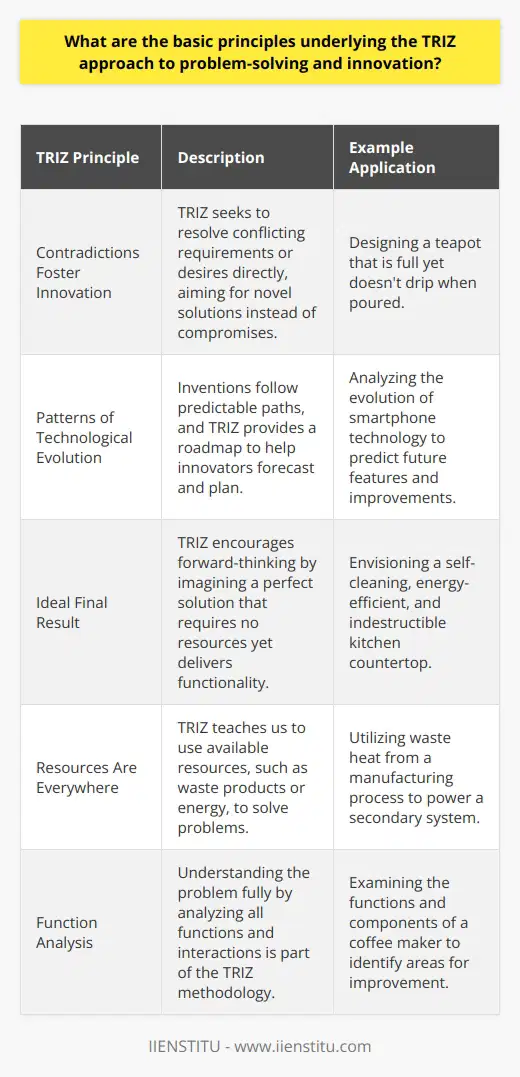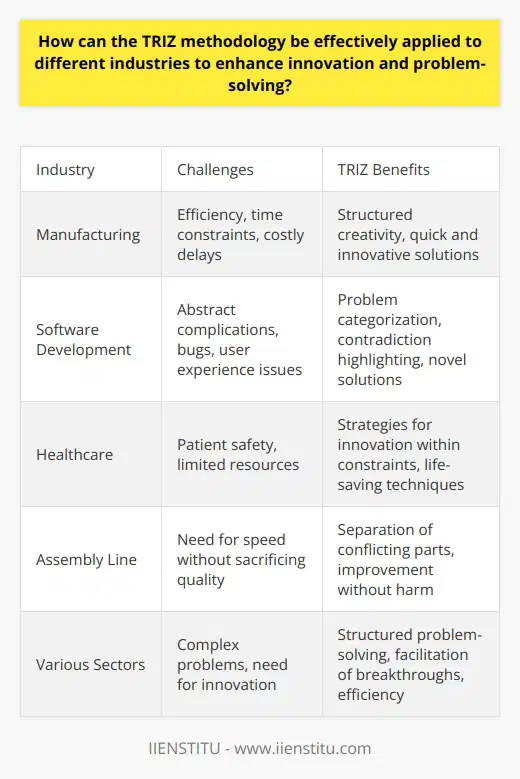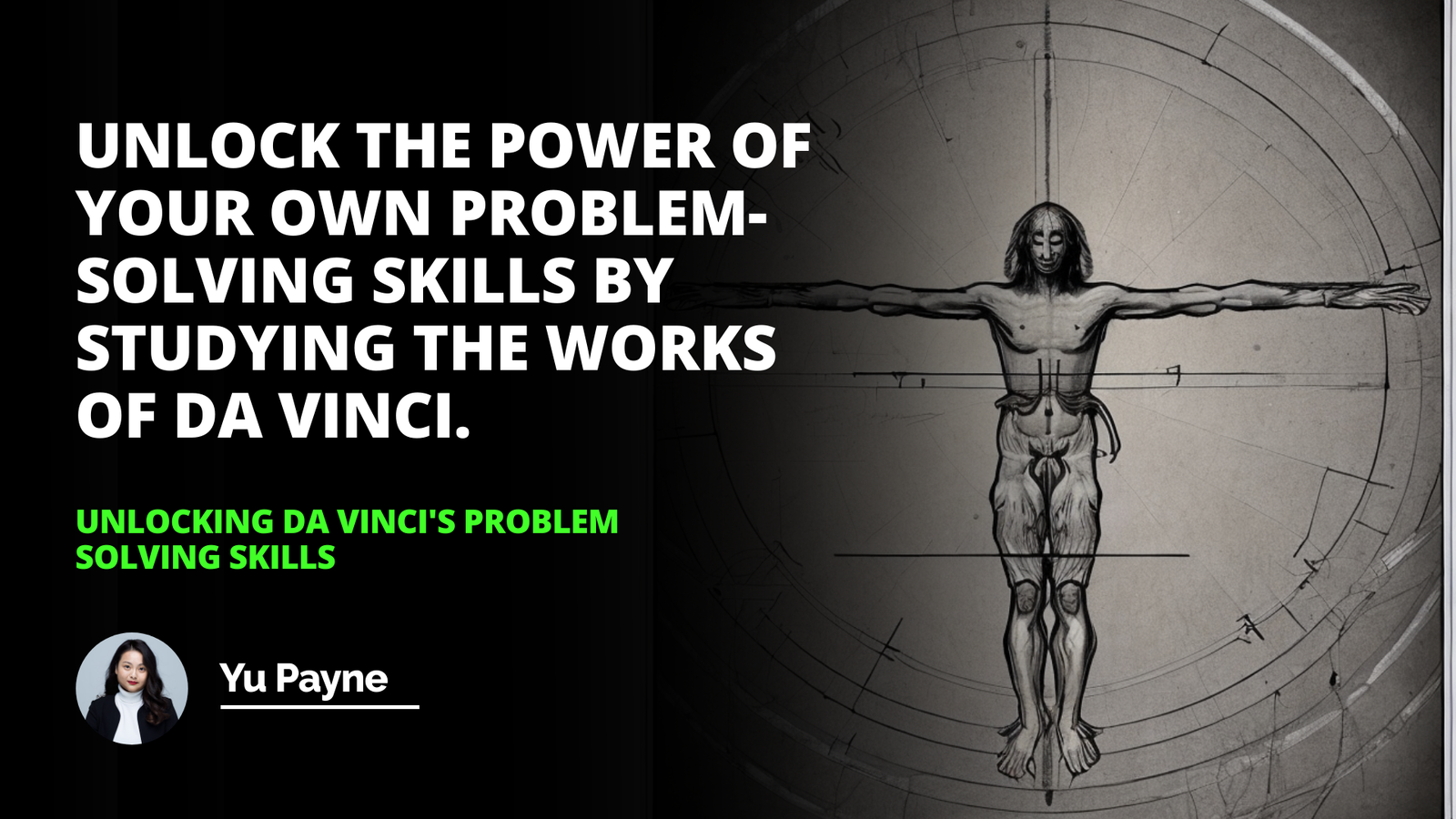
The Theory of Inventive Problem Solving, known as TRIZ, is an insightful methodology developed for systematically approaching innovation and complex problem-solving. Its foundations are deeply rooted in empirical data, gathered from the analysis of thousands of patents to discern patterns that can forecast the direction of future technological advancement. The relevance of TRIZ in today's fast-paced and innovation-driven business realm cannot be overstated.
By equipping professionals with a structured framework for understanding and addressing challenges, TRIZ fosters an environment where creativity and efficiency thrive. As businesses continue to seek differentiation through innovation, TRIZ stands out as a potent tool for transforming the very nature of problems into tangible opportunities for growth and development.
History and Development of TRIZ
Origin and Creator of TRIZ
TRIZ was conceived in the mid-20th century by Soviet inventor and science fiction writer Genrich Altshuller. His epiphany occurred during his tenure at a patent office, where he recognized common themes among numerous inventions that could potentially inspire innovation across various fields.
Altshuller posited that creativity could be codified into a repeatable and systematic process rather than remaining the seemingly mystical result of sporadic genius.
Evolution and Adaptation of TRIZ Over the Years
Since its inception, TRIZ has evolved through continual refinement and practical application, expanding far beyond its original roots within engineering disciplines. Altshuller's initial work has been substantiated and expanded upon by a growing community of thinkers and practitioners who have extended its applicability to diverse sectors including business management, software development, and even social sciences.
Global Acceptance and Implementation of TRIZ in Different Sectors
The relevance of TRIZ is not confined by geographic boundaries. It has been globally recognized and implemented in organizations as they realize its potential to tangibly enhance their innovation capacities. From the automotive industry to consumer electronics giants, TRIZ has transcended cultural and industrial barriers to become a cornerstone of modern inventive thinking and strategic planning.
Pareto Chart: A Powerful Tool for Data Analysis and Decision-Making
Quality Improvement: Strategies, Principles, and Impact on Business Success
Failure Mode, Effects, and Criticality Analysis (FMECA): A Comprehensive Guide
Basic Principles of TRIZ
The 40 Inventive Principles and Their Application
One of the core components of TRIZ is the 40 inventive principles, a set of general tactics for overcoming technical contradictions through novel approaches. For instance, the principle of segmentation — breaking a problem down into its parts — has led to advancements in modular design, wherein components can be replaced or upgraded individually without necessitating the redesign of the entire system.
The Contradiction Matrix and Its Usage
Another pivotal element of TRIZ is the contradiction matrix, which provides strategic recommendations for resolving specific problems without compromising other parameters. It essentially bridges the gap between different inventive principles and the particular characteristics of a problem, guiding the user towards plausible solutions that would otherwise require considerable time and effort to devise.
The Ideality and System Evolution Principles
The principle of ideality presses the visionary pursuit of an ideal final result — a solution that demands no resources yet delivers maximized benefits. Alongside this, the system evolution principles chart a path for the progressive development of a technological system through various stages, predicting and leveraging the natural progression of technical systems over time.
The TRIZ Process
Understanding the Problem and Collecting Data
The initial step in applying TRIZ involves a comprehensive understanding of the problem at hand, which requires meticulous data collection and analysis. Identifying the true nature of the problem rather than its superficial symptoms is critical to direct efforts effectively and to ensure that solutions are both relevant and sustainable.
Analyzing the Problem Through TRIZ Tools
Using TRIZ tools to analyze the problem enables users to reframe challenges in non-standard ways, facilitating fresh perspectives and unexpectedly effective solutions. It involves the strategic deconstruction of the problem into its fundamental components, scrutinizing them through the lens of TRIZ's inventive principles and contradiction matrix.
Developing and Implementing a Solution Using TRIZ Principles
The actual creation and implementation of a solution following the TRIZ framework require iterative prototyping, systematic validation, and refinement. Employing TRIZ principles empowers practitioners to ideate and invent with prowess and precision, often leading to groundbreaking solutions that redefine the market landscape.
Advantages of Applying TRIZ
Improving Efficiency and Effectiveness in Problem Solving
The application of TRIZ significantly augments problem-solving efficiency and effectiveness by offering a structured approach that accelerates the innovation process. This often results in reduced development times and costs, as well as breakthroughs that can create competitive advantages.
Encouraging Innovation and Creativity in Organizations
A notable advantage of TRIZ is its ability to encourage continual innovation and creativity within organizations. TRIZ provides a concrete framework for channeling creative energies more productively, potentially fostering an organizational culture that consistently aspires to innovate.
Case Study to Exemplify the Benefits of TRIZ
A case study illustrating the benefits of TRIZ can be seen in the example of a manufacturing firm that applied the theory to redesign a problematic product assembly line. By identifying and resolving contradictions in the process, the firm was able to both enhance the product quality and increase the assembly line speed, which subsequently led to heightened customer satisfaction and market share growth.
TRIZ in Real-world Scenarios
Implementation of TRIZ in Various Industries With Examples
Across various industries, the implementation of TRIZ has led to the resolution of long-standing issues that were believed to be impervious to improvement. For instance, in the automotive industry, TRIZ has been instrumental in reconciling conflicting goals of reducing vehicle weight while maintaining structural integrity, thereby advancing both fuel economy and safety standards.
How TRIZ is Transforming Traditional Problem-Solving Methods
Traditional problem-solving methods often rely on trial-and-error tactics or incremental improvements. In contrast, TRIZ advocates for a radical re-envisioning of problems that paves the way for inventive solutions, transforming problem-solving into a systematic, foresighted endeavor.
Limitations and Criticism of TRIZ
Possible Pitfalls and Limitations of TRIZ
Although TRIZ presents an array of advantages, it also has its limitations. The complexity and abstract nature of some of its principles can occasionally render it inaccessible or overly challenging for newcomers without proper problem solving skills training.
Criticism and Contrarian Views on TRIZ’s Effectiveness
Some critics argue that TRIZ's heavy reliance on past inventions limits its capacity to predict truly novel innovations. As a reaction, contrarian viewpoints often advocate for a more eclectic or integrated approach to innovation that merges TRIZ with other methodologies.
Recap of Key Points Discussed About TRIZ
TRIZ is a methodological beacon in the realm of inventive problem-solving that systematically enhances an organization's ability to innovate. By dissecting the historical landscape of inventions and distilling repeatable patterns of problem-solving, TRIZ enables businesses to ingeniously tackle challenges that might otherwise stifle progress.
The Future Potential of TRIZ in the Context of the Rapidly Changing Business Environment
As businesses continue to grapple with the unending flux of technological advancements and market dynamics, TRIZ is poised to gain even greater significance. Professionals possessing mastery of TRIZ principles, potentially fortified through online certificate courses, are well-equipped to lead the charge in an era defined by incessant innovation and transformation.
Final Thoughts and Areas for Further Exploration in TRIZ
Continuous exploration in the field of TRIZ, including the development of digital tools and the integration of machine learning algorithms, can expand its utility even further. By embracing both the rich legacy and potential evolution of TRIZ, practitioners and organizations can unlock a profound capacity for inventive and evolutionary change.
Frequently Asked Questions
What are the basic principles underlying the TRIZ approach to problem-solving and innovation?
TRIZ Fundamentals
TRIZ stands for the Theory of Inventive Problem Solving. It hails from Russia. Genrich Altshuller developed it. He based TRIZ on extensive patent analysis. His goal was to universalize invention. How? By identifying patterns in problems and solutions.
Principles at the Core
TRIZ rests on several key principles. We'll explore these briefly.
Contradictions Foster Innovation
Problems often involve contradictions. That is, conflicting requirements or desires. TRIZ aims to resolve these directly. It doesn't settle for compromises. Instead, it seeks novel solutions.
Patterns of Technological Evolution Exist
Inventions follow predictable paths. These are patterns. TRIZ provides a roadmap. This roadmap helps innovators forecast and plan.
Creativity Can Be Systemic
Inspiration isn't always spontaneous. TRIZ offers a structured approach. This guides creativity. It makes innovation more predictable.
Ideal Final Result
Imagine a perfect solution. It requires no resources. Yet, it delivers functionality. TRIZ encourages such forward-thinking. It's the ideal final result.
Resources Are Everywhere
Look around. Every element has potential. TRIZ teaches us to use available resources. Think waste products or energy. They can solve problems.
Inventive Principles
Forty principles guide problem-solving in TRIZ. They offer strategies. You can overcome technical contradictions with these.
Standardized Approaches
TRIZ has standard solutions. These tackle common problems. They're based on past inventions. Why reinvent the wheel?
Function Analysis
Understand the problem fully. Analyze all functions and interactions. This is part of the TRIZ methodology.
Knowledge and Information Tools
TRIZ includes tools and methods. Examples are ARIZ and Algorithm of Inventive Problem Solving. They structure the problem-solving process.
Application of TRIZ
So, how does one apply TRIZ? First, define the problem. Identify the contradictions. Then, analyze the system. Seek the ideal final result. Utilize resources wisely. Apply inventive principles. And, use the knowledge tools.
Example in Action
Consider an overfilled teapot. The problem? It drips when poured. The contradiction? A full pot but no drips. TRIZ would analyze functions. Spout design may be key. Apply inventive principles. Perhaps altering the spout's shape. Use a knowledge tool to guide the redesign. Thus, solve the problem systematically.
TRIZ offers a robust framework. It shifts perspective on problem-solving. With its structured approach, TRIZ makes innovation less daunting. It nurtures creativity systematically. And it offers a strategy for overcoming obstacles to invention and development.

How can the TRIZ methodology be effectively applied to different industries to enhance innovation and problem-solving?
Understanding TRIZ
TRIZ stands for Teoriya Resheniya Izobretatelskikh Zadatch. It means Theory of Inventive Problem Solving. Genrich Altshuller developed it. He hoped to streamline innovation. Researchers and engineers often rely on TRIZ. It provides a systematic approach. This simplifies complex problems.
TRIZ Across Industries
TRIZ transcends industrial boundaries. It adapts to various fields. For instance, it applies to manufacturing, software development, and even healthcare. Each industry has unique challenges. Yet, TRIZ offers a universal toolkit. It fosters creative problem-solving.
Manufacturing
In manufacturing, efficiency is key. Time equals money. Delays can be costly. Workers need quick, innovative solutions. TRIZ brings structure to their creativity. It helps them identify and solve problems fast.
Software Development
Software development deals with abstract complications. Bugs and user experience issues abound. TRIZ assists by categorizing problems. It highlights contradictions. Developers thus find novel solutions.
Healthcare
In healthcare, patient safety is paramount. Yet resources often remain limited. TRIZ equips practitioners with strategies. They can innovate within constraints. Life-saving techniques often emerge.
Applying TRIZ Effectively
Applying TRIZ involves understanding its principles. There are 40 inventive principles. There are also contradiction tables and patterns of evolution. These are essential TRIZ tools.
Initial Assessment
Know your problem. TRIZ starts with clear problem identification. One cannot solve a vague issue.
Contradiction Analysis
Identify contradictions. Problems often have conflicting requirements. TRIZ helps to manage these.
Ideality and Resources
Focus on ideality. TRIZ promotes the ideal solution. Yet it considers available resources. Balance is crucial.
Using TRIZ Tools
Master the tools. The 40 principles guide the thought process. Contradiction tables clarify conflicts. Patterns of evolution predict industry changes.
The TRIZ Process in Action
Consider an assembly line issue. There's a need for speed without sacrificing quality. This is a classic contradiction. TRIZ principles offer solutions. One might separate the conflicting parts. Perhaps improve one without harming the other.
TRIZ remains versatile and effective. It adapts to diverse industries. It simplifies complex problems. Companies can thus foster innovation. Efficiency follows. TRIZ may well be a universal tool. It facilitates breakthroughs across various sectors. Innovation thrives with structured problem-solving.

How does the TRIZ approach challenge traditional thinking and redefine creative problem-solving strategies?
TRIZ Transforms Conventional Problem-Solving
Traditional thinking often takes linear paths. Solutions build on known methods. Challenges look unique and isolated. Familiar strategies dominate the process. Yet, contradictions often block innovation. Complexity further complicates matters. Specialists work within narrow fields. TRIZ disrupts these patterns.
Embracing Systematic Innovation
TRIZ stands for Theory of Inventive Problem Solving. Genrich Altshuller developed it. He studied patents extensively. Patterns emerged from his analysis. Innovations followed identifiable principles. TRIZ encapsulates these into a structured methodology. It offers tools and concepts not found in conventional practice.
Overcoming Psychological Inertia
Psychological inertia stifles creativity. People repeat known patterns. Familiarity breeds comfort. TRIZ challenges this comfort. It pushes users to explore unfamiliar territory. The approach shakes up entrenched habits. By doing so, it opens up new avenues for solving problems.
Solving Problems with Patterns
Patterns underpin TRIZ philosophy. Every problem has a potential solution known elsewhere. TRIZ maps these patterns in problem spaces. Innovation becomes a matter of finding the right pattern. Knowledge transfer between domains flourishes.
Contradictions as Creative Fuel
Traditional thinking discourages contradictions. TRIZ, conversely, welcomes them. Contradictions signify opportunities for breakthroughs. Identifying and resolving them drives innovation. TRIZ provides specific principles for turning contradictions into advantages.
Predictive Problem-Solving
TRIZ enables predictive problem-solving. Trends of system evolution form its backbone. Designers and engineers anticipate problems and solutions. Future challenges become less daunting. TRIZ guides users to evolve their systems proactively.
System-Oriented Approach
TRIZ adopts a holistic viewpoint. It sees products as systems. These systems interact with other systems. Optimization thus involves the complete ecosystem. This perspective moves beyond isolated fixes. Sustainable solutions emerge as a result.
Knowledge Democratization
TRIZ democratizes problem-solving. It treats innovation as a skill that can be taught. Complex problems no longer require exclusive expertise. With TRIZ, diverse teams tackle sophisticated dilemmas. Knowledge sharing is integral to this process.
Multi-Level Problem Solving
Different problems demand different solutions. TRIZ acknowledges this with multi-level strategies. Surface-level issues receive simple fixes. Deep-rooted problems undergo thorough analysis. Multiple aspects of a problem get attention simultaneously.
Leveraging Resources
Resources often seem limited in traditional thinking. TRIZ turns every element of a system into a potential resource. Nothing is inconsequential. Hidden opportunities present themselves. Users tap into underutilized assets within their environment.
TRIZ redefines creativity in problem-solving. It challenges norms and fosters systematic innovation. This approach empowers individuals to transcend their cognitive and professional constraints. Consequently, TRIZ equips organizations to navigate the complexities of modern challenges efficiently.



